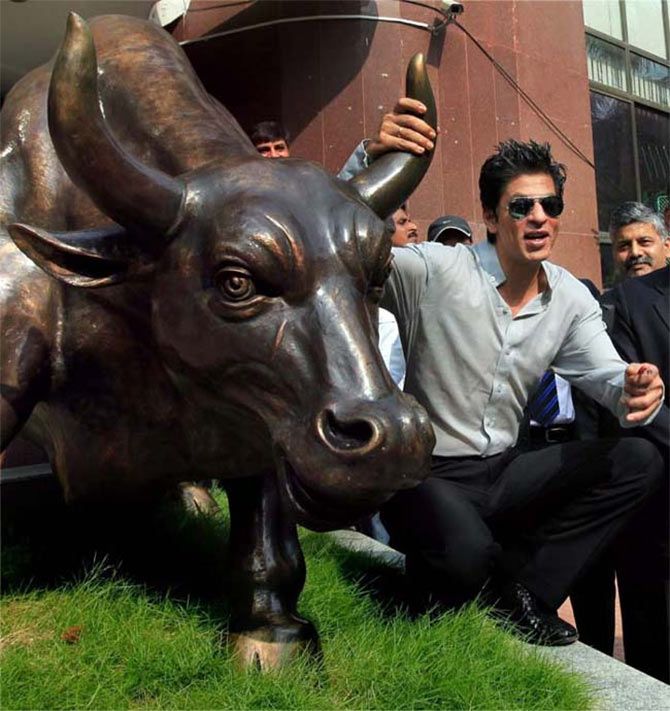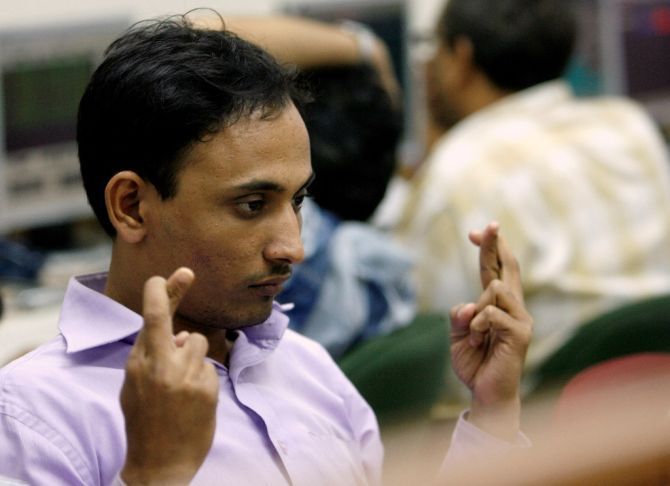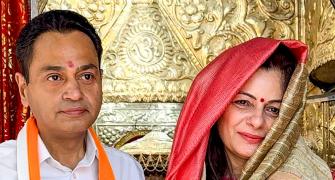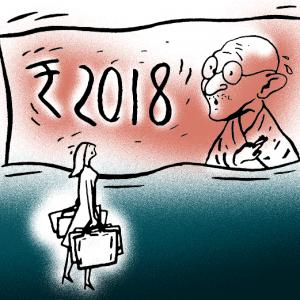The one common theme across companies that have rewarded shareholders is consumption, says Niraj Bhatt.

IMAGE: Shah Rukh Khan poses with the one tonne, five feet tall, bronze bull outside the Bombay Stock Exchange. Photograph: PTI
On January 11, 2008, the Bombay Stock Exchange welcomed a bronze bull, five feet tall and weighing a tonne.
It couldn't have come at a more opportune time -- the bull market had begun in 2005 and, just three days earlier, the Sensex had closed at its life-time high.
Ratan Tata's Rs 1 lakh car, the Nano, launched the previous day, was making India proud, Reliance Power was slated to make history as the largest initial public offering in stock market history the next week and Aamir Khan's Christmas release, Taare Zameen Par, was spreading hope in cinemas.
Just two weeks later, investors started finding stocks expensive and the market cracked.
The sub-prime credit problems in the US were becoming bigger and fears of a global contagion pushed stock prices lower.
The global financial crisis soon engulfed the world and by February 2009, the Sensex was down 57 per cent from the January 2008 high.
The subsequent years were difficult for the economy and industry; and an all-round recovery is still waiting to happen.
The Sensex is up just 62 per cent since January 2008.
The last 10 years have seen the emergence of new sector and stock leaders, while some well-known names have fallen by the wayside.
A look at the winners and losers since the last bull market.

IMAGE: Symphony became debt-free with a positive net worth in June 2008, and went on to become the biggest gainer on the stock market in the next 10 years.
The share price of air cooler-maker Symphony had tripled year-on-year on January 8, 2008, as the company finally turned profit-making.
A diversification into geysers, air conditioners and water purifiers a few years earlier had failed and the company was facing debt restructuring. That's when Symphony Chairman and MD Achal Bakeri decided to exit all other products, focus on air coolers and expand market presence.
"We increased our distributors in India and started looking at markets outside the country. We could put all our resources into bringing innovation to this one category," says Bakeri.
Today, its coolers have features such as a touchscreen, ultrasonic mosquito repellent and air purification.
Symphony became debt-free with a positive net worth in June 2008, and went on to become the biggest gainer on the stock market in the next 10 years.
Between 2007 and 2017, Symphony's revenue has risen 18 times, its net profit is up 77 times and its debt-equity ratio is small.
The stock went up 450 times, a compounded growth rate of 83 per cent a year.
Companies that have innovated with new products or services, identified new markets or captured a niche have done well on the bourses.
Shares of Caplin Point have appreciated 73 per cent each year in the past 10 years as the pharmaceutical company found a niche in selling low-cost medicines in the largely overlooked markets of South America.

IMAGE: MD and CEO Siddhartha Lal, who tweeted this picture of the Royal Enfield being tested in the Himalayas, took over the struggling, loss-making Royal Enfield motorcycle business in 2000, and turned it into the iconic brand it is today. Photograph: Kind courtesy Siddhartha Lal/Twitter
No story on stock market returns in recent years can be complete without the mention of Eicher Motors whose MD and CEO Siddhartha Lal took over the struggling, loss-making Royal Enfield motorcycle business in 2000, and turned it into the iconic brand it is today by fixing design, engineering and marketing.
The company's market capitalisation has risen from Rs 1,130 crore in January 2008 to Rs 82,040 crore now.
For a brief period in 2017, Eicher even overtook the most valued two-wheeler company, Bajaj Auto, in terms of market capitalisation though its sales and profits were a third of Bajaj's.
However, among big business houses, the Bajaj group has created the maximum shareholder value since the 2008 Sensex high, with the group's financial services business growing at an astonishing pace.
Three companies -- Bajaj Holdings, Bajaj Auto and Bajaj Finserv -- were created from the flagship Bajaj Auto in 2007-2008.
Bajaj Finance, a small non-banking finance company, continued to remain a separate entity.
Finance companies gave consumer loans to the rising middle-class, which was buying automobiles and consumer goods like never before.

IMAGE: Bajaj Finance and its holding company, Bajaj Finserv, which also owns both life and general insurance subsidiaries, command a combined market capitalisation of Rs 1.85 lakh crore. Photograph: Kind courtesy Bajaj Finserv/Twitter
Bajaj Finance and its holding company, Bajaj Finserv, which also owns both life and general insurance subsidiaries, command a combined market capitalisation of Rs 1.85 lakh crore -- up from Rs 1,900 crore (Bajaj Finance alone) in January 2008.
IndusInd Bank's share prices grew at 30 per cent a year in the decade, taking the Hinduja group to second place in shareholder value creation.
The Nusli Wadia group saw its market cap spurt from under Rs 10,000 crore in January 2008 to Rs 75,000 crore as food company Britannia Industries became a 15-bagger.
Group companies Bombay Burmah and National Peroxide were also solid performers, while the flagship Bombay Dyeing remained a laggard and accounts for only 8 per cent of the group's market cap.

IMAGE: HDFC Bank shares appreciated eight times. Photograph: Kind courtesy HDFC Bank/Twitter
HDFC Bank shares appreciated eight times, and took the HDFC group to second place in terms of market cap.
The recent listing of HDFC Standard Life Insurance helped it widen the gap with the Mukesh Ambani group, the third largest.
Flagship Reliance Industries shares gained at 2 per cent compounded annual growth rate (CAGR).
The Tata group, the largest in terms of market capitalisation, has seen its shareholders' investments double in the 10-year period, led by five-bagger TCS and 10-bagger Titan.
Ace investor Rakesh Jhunjhunwala's investment in Titan has multiplied from Rs 662 crore in January 2008 to Rs 6,000 crore now based on his September 2017 holdings.

IMAGE: Anil Ambani at an annual general meeting of Reliance Capital. Photograph: Danish Siddiqui/Reuters
Anil Ambani's Reliance group was ranked at third place with his companies commanding a market cap of Rs 3.4 lakh crore in January 2008; it now stands at Rs 78,630 crore.
The group's shares had shot up on the bourses in 2008.
Reliance Communications' debt problem and the entry of Jio have resulted in the stock price losing over 95 per cent of its 2008 value.
Reliance Capital and Reliance Infrastructure are also about a quarter of their value though the group's finance business is in good shape.
Indebted groups like Jaypee and Navin Jindal lost their shareholders' money.
The exuberance of bull markets drives stocks to lofty valuations.
Managements become over optimistic and take risks as they expand capacities, acquire companies, venture into new areas or get plain complacent.
The major fallout of these risks is that companies take loans confidently, which in a low-growth period becomes difficult to service.
In the current market scenario, this is not the situation.
Many of the underperformers since 2008 have high debt.
On the other hand, companies that have done well are those that respect capital -- they are frugal in raising fresh equity capital and do not borrow much either.

IMAGE: About 60 per cent of the companies accounting for two-thirds of the 2008 market capitalisation have not beaten the Sensex over the 10-year period. Photograph: Danish Siddiqui/Reuters
Long-term value creation has been a difficult task even for professional money managers.
About 60 per cent of the companies accounting for two-thirds of the 2008 market capitalisation have not beaten the Sensex over the 10-year period.
The Sensex has returned an annualised 5 per cent from the 2008 high to now, excluding dividends, while the 10-year State Bank of India fixed deposit was earning an interest of 9 per cent in 2008, which at the highest tax bracket works out to 6.3 per cent -- without the equity risk.
The average large-cap equity mutual fund has done better, at 7.2 per cent, in the same period according to data from Value Research, as fund managers move in and out of stocks.
The one common theme across companies that have rewarded shareholders is consumption.
The past decade has seen a spurt in sales of passenger vehicles, motorcycles, consumer durables and consumer loans.
Both car and two-wheeler sales have more than doubled.
Indian consumers, who would hesitate taking loans, are now quite comfortable borrowing to buy an iPhone X.
As a result, shares of automobiles, auto ancillaries, private sector banks and finance companies have all done well.
In the next decade, sectors such as automobiles and banking will see massive disruption, led by technology and digitisation.
A younger population, urbanisation, nuclear families, rising aspirations and availability of credit will mean that consumption will continue to grow.
In 2007, McKinsey had forecast that India would become the fifth-largest consumer market in the world by 2025; the Boston Consulting Group believes it will be the third.
Consumer preference for brands and the goods and services tax regime will result in a shift from the unorganised to the organised sector.
For consumer-focused companies, the going will only be good.











